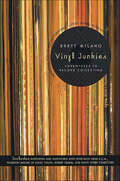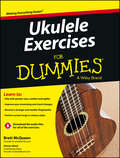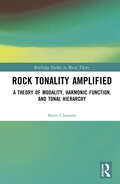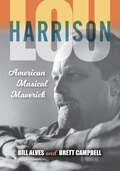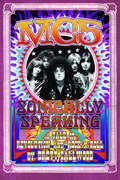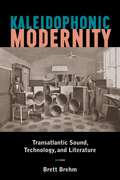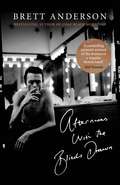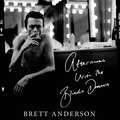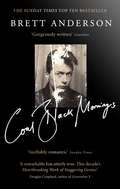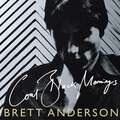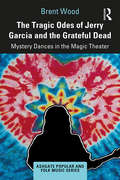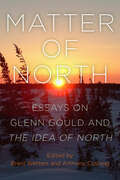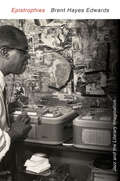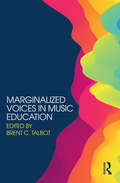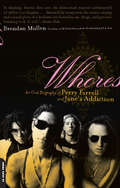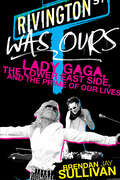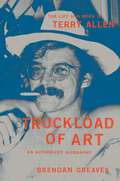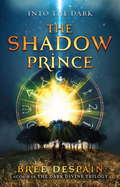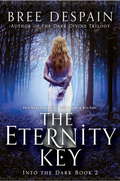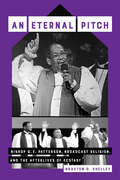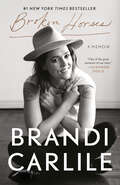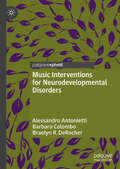- Table View
- List View
Vinyl Junkies: Adventures in Record Collecting
by Brett MilanoNot too far away from the flea markets, dusty attics, cluttered used record stores and Ebay is the world of the vinyl junkies. Brett Milano dives deep into the piles of old vinyl to uncover the subculture of record collecting. A vinyl junkie is not the person who has a few old 45s shoved in the cuboard from their days in high school. Vinyl Junkies are the people who will travel over 3,000 miles to hear a rare b-side by a German band that has only recorded two songs since 1962, vinyl junkies are the people who own every copy of every record produced by the favorite artist from every pressing and printing in existance, vinyl junkies are the people who may just love that black plastic more than anything else in their lives. Brett Milano traveled the U.S. seeking out the most die-hard and fanatical collectors to capture all that it means to be a vinyl junkie. Includes interviews with Thurston Moore of Sonic Youth, Peter Buck from R.E.M and Robert Crumb, creator of Fritz the cat and many more underground comics.
Ukulele Exercises For Dummies
by Alistair Wood Brett McqueenTake your ukulele playing to the next level - fast! - with hundreds of fun exercises, drills and practice tunesYou have a ukulele, you know just enough to be dangerous, and now you're ready to do something with it. You're in luck: Ukulele Exercises For Dummies helps you become a better player. This practice-based book focuses on the skills that entry-level players often find challenging and provides tips, tricks and plenty of cool exercises that will have you creating music in no time that include:* Creating rock-steady strumming patterns and rhythms* Becoming a better fingerpicker with patterns, arpeggio exercises, and solo fingerpicking pieces* Expanding your fretboard knowledge and crafting your own rock, blues and jazz riffs and solos* Playing actual songs on the ukulele - everything from the classic ukulele tunes to the 12 bar blues!* Downloadable audio files of the exercises found in the book, providing you with a self-contained practice packageNo matter if you're a beginning ukulele player or you're wanting to stretch and improve your chops, Ukulele Exercises For Dummies puts you on your way to becoming a ukulele extraordinaire!
Rock Tonality Amplified: A Theory of Modality, Harmonic Function, and Tonal Hierarchy (Routledge Studies in Music Theory)
by Brett ClementRock Tonality Amplified presents an in-depth exploration of rock tonality. Building on several decades of research, this book develops a comprehensive music theory designed to make sense of several essential components of tonality. Within, readers learn to locate the chords they hear through various methods, to understand and predict harmonic resolution tendencies, and to identify the functions of chords as they appear in musical contexts. Further, the book offers a conceptual framework to describe tonal relations that are played out through entire songs, allowing readers to recognize the features that contribute to tonal unity in songs and the ones that are employed to create musical drama. The book contributes to a wealth of methodologies in music theory, making it of broad interest to music scholars and students. Further, it balances speculative and practical approaches so that it has clear applications for analysis and pedagogy. It includes numerous musical figures and cites hundreds of songs from a wide variety of artists. Each chapter concludes with additional practice activities, allowing for easy adaptation to various pedagogical purposes.
Lou Harrison: American Musical Maverick
by Bill Alves Brett CampbellA biography on the legendary gay American composer of contemporary classical music.American composer Lou Harrison (1917–2003) is perhaps best known for challenging the traditional musical establishment along with his contemporaries and close colleagues: composers John Cage, Aaron Copland, Virgil Thomson, and Leonard Bernstein; Living Theater founder, Judith Malina; and choreographer, Merce Cunningham. Today, musicians from Bang on a Can to Björk are indebted to the cultural hybrids Harrison pioneered half a century ago. His explorations of new tonalities at a time when the rest of the avant-garde considered such interests heretical set the stage for minimalism and musical post-modernism. His propulsive rhythms and ground-breaking use of percussion have inspired choreographers from Merce Cunningham to Mark Morris, and he is considered the godfather of the so-called “world music” phenomenon that has invigorated Western music with global sounds over the past two decades.In this biography, authors Bill Alves and Brett Campbell trace Harrison’s life and career from the diverse streets of San Francisco, where he studied with music experimentalist Henry Cowell and Austrian composer Arnold Schoenberg, and where he discovered his love for all things non-traditional (Beat poetry, parties, and men); to the competitive performance industry in New York, where he subsequently launched his career as a composer, conducted Charles Ives’s Third Symphony at Carnegie Hall (winning the elder composer a Pulitzer Prize), and experienced a devastating mental breakdown; to the experimental arts institution of Black Mountain College where he was involved in the first “happenings” with Cage, Cunningham, and others; and finally, back to California, where he would become a strong voice in human rights and environmental campaigns and compose some of the most eclectic pieces of his career.“Lou Harrison’s avuncular personality and tuneful music coaxed affectionate regard from all who knew him, and that affection is evident on every page of Alves and Campbell’s new biography. Eminently readable, it puts Harrison at the center of American music: he knew everyone important and was in touch with everybody, from mentors like Henry Cowell and Arnold Schoenberg and Charles Ives and Harry Partch and Virgil Thomson to peers like John Cage to students like Janice Giteck and Paul Dresher. He was larger than life in person, and now he is larger than life in history as well.” —Kyle Gann, author of Charles Ives’s Concord: Essays After a Sonata
MC5: Sonically Speaking
by Brett CallwoodA definitive history of the MC5 that considers the band's musical legacy and revolutionary political roots.
Kaleidophonic Modernity: Transatlantic Sound, Technology, and Literature
by Brett BrehmWhat stories remain hidden behind one of the most significant inventions of the nineteenth century? Kaleidophonic Modernity reexamines the development of mechanical sound recording technology by charting the orbits of writers, scientists, and artists in France and the United States. Working between comparative literature, the history of science, and urban studies, Brehm builds a bridge between visual culture and sound studies.Kaleidophonic Modernity places the poet and inventor Charles Cros and his lover, the celebrated concert pianist and salonnière Nina de Villard at the heart of modern aesthetic and scientific vanguards. Cros's scientific endeavors ranged from color photography, to telecommunications, to mechanical sound reproducibility. In his poetry the Surrealists found an ancestor and inspiration. His literary and scientific works prove startling and relevant to predicaments of technological media in his own time and ours. For nearly twenty years Nina de Villard presided over a supremely daring intellectual salon. There, she welcomed manifold literary, artistic, and musical luminaries into a veritable crucible of the artistic avant-garde and precursor to the famous Chat Noir cabaret. Together, these two forgotten but pivotal figures, Cros and Villard, help reframe our thinking on Edgar Allan Poe, Charles Baudelaire, and Walt Whitman, icons of urban modernity who can now be seen and heard in a kaleidophonic light, one that offers a compelling new perspective on modern mediascapes.In elaborating this transatlantic phenomenon, Kaleidophonic Modernity illuminates the prehistory of the phonograph as it intersects with the aesthetics of sound reproducibility, Franco-American literary exchange, Poe’s aesthetic and intellectual legacy, the sounds of modern cities and technologies, and the genealogy of audiovisual experimentation found in such movements as Dada, Futurism, and the sound art of today.
Afternoons with the Blinds Drawn
by Brett Anderson'A compelling personal account of the dramas of a singular British band' Neil TennantThe trajectory of Suede - hailed in infancy as both 'The Best New Band in Britain' and 'effete southern wankers' - is recalled with moving candour by its frontman Brett Anderson, whose vivid memoir swings seamlessly between the tender, witty, turbulent, euphoric and bittersweet. Suede began by treading the familiar jobbing route of London's emerging new 1990s indie bands - gigs at ULU, the Camden Powerhaus and the Old Trout in Windsor - and the dispiriting experience of playing a set to an audience of one. But in these halcyon days, their potential was undeniable. Anderson's creative partnership with guitarist Bernard Butler exposed a unique and brilliant hybrid of lyric and sound; together they were a luminescent team - burning brightly and creating some of the era's most revered songs and albums.In Afternoons with the Blinds drawn, Anderson unflinchingly explores his relationship with addiction, heartfelt in the regret that early musical bonds were severed, and clear-eyed on his youthful persona. 'As a young man . . . I oscillated between morbid self-reflection and vainglorious narcissism' he writes. His honesty, sharply self-aware and articulate, makes this a compelling autobiography, and a brilliant insight into one of the most significant bands of the last quarter century.
Afternoons with the Blinds Drawn
by Brett Anderson'A compelling personal account of the dramas of a singular British band' Neil TennantThe trajectory of Suede - hailed in infancy as both 'The Best New Band in Britain' and 'effete southern wankers' - is recalled with moving candour by its frontman Brett Anderson, whose vivid memoir swings seamlessly between the tender, witty, turbulent, euphoric and bittersweet. Suede began by treading the familiar jobbing route of London's emerging new 1990s indie bands - gigs at ULU, the Camden Powerhaus and the Old Trout in Windsor - and the dispiriting experience of playing a set to an audience of one. But in these halcyon days, their potential was undeniable. Anderson's creative partnership with guitarist Bernard Butler exposed a unique and brilliant hybrid of lyric and sound; together they were a luminescent team - burning brightly and creating some of the era's most revered songs and albums.In Afternoons with the Blinds drawn, Anderson unflinchingly explores his relationship with addiction, heartfelt in the regret that early musical bonds were severed, and clear-eyed on his youthful persona. 'As a young man . . . I oscillated between morbid self-reflection and vainglorious narcissism' he writes. His honesty, sharply self-aware and articulate, makes this a compelling autobiography, and a brilliant insight into one of the most significant bands of the last quarter century.
Afternoons with the Blinds Drawn
by Brett Anderson'A compelling personal account of the dramas of a singular British band' Neil TennantThe trajectory of Suede - hailed in infancy as both 'The Best New Band in Britain' and 'effete southern wankers' - is recalled with moving candour by its frontman Brett Anderson, whose vivid memoir swings seamlessly between the tender, witty, turbulent, euphoric and bittersweet. Suede began by treading the familiar jobbing route of London's emerging new 1990s indie bands - gigs at ULU, the Powerhaus and the Old Trout in Windsor - and the dispiriting experience of playing a set to an audience of one. But in these halcyon days, their potential was undeniable. Anderson's creative partnership with guitarist Bernard Butler exposed a unique and brilliant hybrid of lyric and sound; together they were a luminescent team - burning brightly and creating some of the era's most revered songs and albums.In Afternoons with the Blinds drawn, Anderson unflinchingly explores his relationship with addiction, heartfelt in the regret that early musical bonds were severed, and clear-eyed on his youthful persona. 'As a young man . . . I oscillated between morbid self-reflection and vainglorious narcissism' he writes. His honesty, sharply self-aware and articulate, makes this a compelling autobiography, and a brilliant insight into one of the most significant bands of the last quarter century.
Coal Black Mornings
by Brett AndersonEvening Standard Book of the Year. Observer Book of the Year. Guardian Book of the Year. Sunday Times Book of the Year. Telegraph Book of the Year. New Statesman Book of the Year. Herald Book of the Year. Mojo Book of the Year.Brett Anderson came from a world impossibly distant from rock star success, and in Coal Black Mornings he traces the journey that took him from a childhood as 'a snotty, sniffy, slightly maudlin sort of boy raised on Salad Cream and milky tea and cheap meat' to becoming founder and lead singer of Suede.Anderson grew up in Hayward's Heath on the grubby fringes of the Home Counties. As a teenager he clashed with his eccentric taxi-driving father (who would parade around their council house dressed as Lawrence of Arabia, air-conducting his favourite composers) and adored his beautiful, artistic mother. He brilliantly evokes the seventies, the suffocating discomfort of a very English kind of poverty and the burning need for escape that it breeds. Anderson charts the shabby romance of creativity as he travelled the tube in search of inspiration, fuelled by Marmite and nicotine, and Suede's rise from rehearsals in bedrooms, squats and pubs. And he catalogues the intense relationships that make and break bands as well as the devastating loss of his mother.Coal Black Mornings is profoundly moving, funny and intense - a book which stands alongside the most emotionally truthful of personal stories.
Coal Black Mornings
by Brett AndersonBrett Anderson came from a world impossibly distant from rock star success, and in Coal Black Mornings he traces the journey that took him from a childhood as 'a snotty, sniffy, slightly maudlin sort of boy raised on Salad Cream and milky tea and cheap meat' to becoming founder and lead singer of Suede.Anderson grew up in Hayward's Heath on the grubby fringes of the Home Counties. As a teenager he clashed with his eccentric taxi-driving father (who would parade around their council house dressed as Lawrence of Arabia, air-conducting his favourite composers) and adored his beautiful, artistic mother. He brilliantly evokes the seventies, the suffocating discomfort of a very English kind of poverty and the burning need for escape that it breeds. Anderson charts the shabby romance of creativity as he travelled the tube in search of inspiration, fuelled by Marmite and nicotine, and Suede's rise from rehearsals in bedrooms, squats and pubs. And he catalogues the intense relationships that make and break bands as well as the devastating loss of his mother.Coal Black Mornings is profoundly moving, funny and intense - a book which stands alongside the most emotionally truthful of personal stories.
Coal Black Mornings
by Brett AndersonListen to the end for an audiobook exclusive: Brett Anderson in conversation with Matt Thorne, author of Prince. Brett Anderson came from a world impossibly distant from rock star success, and in Coal Black Mornings he traces the journey that took him from a childhood as 'a snotty, sniffy, slightly maudlin sort of boy raised on Salad Cream and milky tea and cheap meat' to becoming founder and lead singer of Suede.Anderson grew up in Hayward's Heath on the grubby fringes of the Home Counties. As a teenager he clashed with his eccentric taxi-driving father (who would parade around their council house dressed as Lawrence of Arabia, air-conducting his favourite composers) and adored his beautiful, artistic mother. He brilliantly evokes the seventies, the suffocating discomfort of a very English kind of poverty and the burning need for escape that it breeds. Anderson charts the shabby romance of creativity as he travelled the tube in search of inspiration, fuelled by Marmite and nicotine, and Suede's rise from rehearsals in bedrooms, squats and pubs. And he catalogues the intense relationships that make and break bands as well as the devastating loss of his mother.Coal Black Mornings is profoundly moving, funny and intense - a book which stands alongside the most emotionally truthful of personal stories.
The Tragic Odes of Jerry Garcia and The Grateful Dead: Mystery Dances in the Magic Theater (Ashgate Popular and Folk Music Series)
by Brent WoodThe Tragic Odes of Jerry Garcia and the Grateful Dead is a multifaceted study of tragedy in the group’s live performances showing how Garcia brought about catharsis through dance by leading songs of grief, mortality, and ironic fate in a collective theatrical context. This musical, literary, and historical analysis of thirty-five songs with tragic dimensions performed by Garcia in concert with the Grateful Dead illustrates the syncretic approach and acute editorial ear he applied in adapting songs of Robert Hunter, Bob Dylan, and folk tradition. Tragically ironic situations in which Garcia found himself when performing these songs are revealed, including those related to his opiate addiction and final decline. This book examines Garcia’s musical craftsmanship and the Grateful Dead’s collective art in terms of the mystery-rites of ancient Greece, Friedrich Nietzsche’s Dionysus, 20th century American music rooted in New Orleans, Hermann Hesse’s Magic Theater, and the Greek Theatre at Berkeley, offering a clear prospect on an often misunderstood phenomenon. Featuring interdisciplinary analysis, close attention to musical and poetic strategies, and historical and critical contexts, this book will be of interest to scholars and researchers of Popular Music, Musicology, Cultural Studies, and American Studies, as well as to the Grateful Dead’s avid listeners.
Matter of North: Essays on Glenn Gould and The Idea of North
by Brent Wetters Anthony CushingDocuments and illuminates Glenn Gould's groundbreaking radio composition, The Idea of North.Matter of North collects essays and source material related to Glenn Gould's landmark 1967 radio documentary The Idea of North. The most famous product (other than his studio piano recordings) of Gould's 1964 decision to abandon the concert stage for the recording studio, it combines Gould's interests in the contrapuntal (by the simultaneous layering of speaking voices) with philosophy and a life-long fascination with the Canadian Arctic. Because the documentary is a multivalent work, the contributors approach the documentary from unique perspectives (sociological, philosophical, music-theoretical, ethnomusicological), each illuminating a salient aspect of the work. The source-material section includes for the first time the complete interview responses by Gould's five participants, along with other important documentation.
Epistrophies: Jazz And The Literary Imagination
by Brent Hayes EdwardsHearing across media is the source of innovation in a uniquely African American sphere of art-making and performance, Brent Hayes Edwards writes. He explores this fertile interface through case studies in jazz literature—both writings informed by music and the surprisingly large body of writing by jazz musicians themselves.
Epistrophies: Jazz and the Literary Imagination
by Brent Hayes EdwardsHearing across media is the source of innovation in a uniquely African American sphere of art-making and performance, Brent Hayes Edwards writes. He explores this fertile interface through case studies in jazz literature—both writings informed by music and the surprisingly large body of writing by jazz musicians themselves.
Marginalized Voices in Music Education
by Brent C. TalbotMarginalized Voices in Music Education explores the American culture of music teachers by looking at marginalization and privilege in music education as a means to critique prevailing assumptions and paradigms. In fifteen contributed essays, authors set out to expand notions of who we believe we are as music educators -- and who we want to become. This book is a collection of perspectives by some of the leading and emerging thinkers in the profession, and identifies cases of individuals or groups who had experienced marginalization. It shares the diverse stories in a struggle for inclusion, with the goal to begin or expand conversation in undergraduate and graduate courses in music teacher education. Through the telling of these stores, authors hope to recast music education as fertile ground for transformation, experimentation and renewal.
Whores: An Oral Biography of Perry Farrell and Jane's Addiction
by Brendan MullenJane's Addiction's 1988 breakthrough album, Nothing's Shocking, had a seismic impact on the music scene of the late 80s. With a bracing combination of metal, punk, and psychedelica, coupled with lead singer Perry Farrell's banshee-in-a-windtunnel vocals, the arrival of Jane's Addiction put what would soon be co-opted as "alternative" on the map. Rising from the depths of Venice Beach's junkie-surfer demonade, Jane's Addiction freely mixed the decadent with the innocent, and paved the way for the mainstream success of bands like the Red Hot Chili Peppers and Nirvana. After Nothing's Shocking, Jane's Addiction released another classic album, Ritual de Lo Habitual (featuring the hit "Been Caught Stealing"), founded the Lollapalooza festival, and openly celebrated a bacchanalian lifestyle that blurred all lines of gender and sexuality. Drawn from original interviews with the band (including Farrell and guitarist Dave Navarro), their friends, and musical colleagues, Whores will take readers through the early days of the band to their drug-addled breakup and eventual triumphant reunion with the 2003 release of their album Strays. Along the way, providing a candid, sometimes disturbing glimpse into the dynamic alternative rock scene of Los Angeles in the '80s and '90s.
Rivington Was Ours: Lady Gaga, the Lower East Side, and the Prime of Our Lives
by Brendan Jay Sullivan“Equal parts insightful, funny, romantic and poetic, this is a book that’s not just about Gaga but about the magic of the city.” —Captain” Kirk Douglas, guitarist for The RootsBrendan Jay Sullivan was an up-and-coming DJ in New York City when he met Stefani Germanotta, then a struggling artist, in 2006. She was a go-go dancer who sewed her own outfits but had bigger ambitions—she wanted nothing less than to take over the music world.In this intimate portrait of the budding star, the author describes afternoons sitting with Gaga on the floor of her bare Lower East Side apartment, drinking wine from pint glasses and plotting out the pop stardom that awaited her.Filled with stories of love and heartbreak among Gaga and Sullivan and their circle of aspiring musicians and performers, and set against the vibrant backdrop of the downtown bars and parties of the mid-aughts, Rivington Was Ours is both a love letter to New York and a glimpse behind the veil of one of the biggest musical icons of her generation.“Entertaining . . . An intimate portrait of a specific time—before stardom struck—and a particular place. Fans of Gaga and the downtown New York music scene will find this fascinating.” —Booklist “A fascinating and vivid insight into the cauldron that formed a great musician.” —Andy Rourke, bass guitarist for The Smiths“Brendan Jay Sullivan is a writer’s writer. Yes, he’s that good.” —Gary Shteyngart, New York Times–beststelling author of Super Sad True Love Story“A touching memoir.” —New York Post
Truckload of Art: The Life and Work of Terry Allen—An Authorized Biography
by Brendan GreavesThe definitive, authorized, and first-ever biography of Terry Allen, the internationally acclaimed visual artist and iconoclastic songwriter who occupies an utterly unique position straddling the disparate, and usually distant, worlds of conceptual art and country music. &“People tell me it&’s country music,&” Terry Allen has joked, &“and I ask, &‘Which country?&’&” For nearly sixty years, Allen&’s inimitable art has explored the borderlands of memory, crossing boundaries between disciplines and audiences by conjuring indelible stories out of the howling West Texas wind. In Truckload of Art, author Brendan Greaves exhaustively traces the influences that shaped Allen&’s extraordinary life, from his childhood in Lubbock, Texas, spent ringside and sidestage at the wrestling matches and concerts his father promoted, to his formative art-school years in incendiary 1960s Los Angeles, and through subsequent decades doggedly pursuing his uncompromising artistic vision. With humor and critical acumen, Greaves deftly recounts how Allen built a career and cult following with pioneering independent records like Lubbock (on everything) (1979)—widely considered an archetype of alternative country—and multiyear, multimedia bodies of richly narrative, interconnected art and theatrical works, including JUAREZ (ongoing since 1968), hailed as among the most significant statements in the history of American vernacular music and conceptual art. Drawing on hundreds of revealing interviews with Allen himself, his family members, and his many notable friends, colleagues, and collaborators—from musicians like David Byrne and Kurt Vile to artists such as Bruce Nauman and Kiki Smith—and informed by unprecedented access to the artist&’s home, studio, journals, and archives, Greaves offers a poetic, deeply personal portrait of arguably the most singularly multivalent storyteller of the American West.
Into the Dark Book #1: The Shadow Prince
by Bree DespainHaden Lord, the disgraced prince of the Underrealm, has been sent to the mortal world to entice a girl into returning with him to the land of the dead. Posing as a student at Olympus Hills High--a haven for children of the rich and famous--Haden must single out the one girl rumored to be able to restore immortality to his race. Daphne Raines has dreams much bigger than her tiny southern Utah town, so when her rock star dad suddenly reappears, offering her full tuition to Olympus Hills High's prestigious music program, she sees an opportunity to catch the break she needs to make it as a singer. But upon moving into her estranged father's mansion in California, and attending her glamorous new school, Daphne soon realizes she isn't the only student in Olympus who doesn't quite belong. Haden and Daphne--destined for each other--know nothing of the true stakes their fated courtship entails. As war between the gods brews, the teenagers' lives collide. But Daphne won't be wooed easily and when it seems their prophesied link could happen, Haden realizes something he never intended--he's fallen in love. Now to save themselves, Haden and Daphne must rewrite their destinies. But as their destinies change, so do the fates of both their worlds. A pulsating romance of epic proportions, Bree Despain's The Shadow Prince will leave her fans breathless for the next book in the Into The Dark series.
Into the Dark Book #2: The Eternity Key
by Bree DespainFan-favorite author Bree Despain continues her modern-day romance trilogy inspired by the Greek myth of Persephone and Hades with this second book in her Into the Dark series. Haden Lord, the disgraced Prince of the Underrealm, has chosen love over honor and will do everything in his power to protect Daphne Raines, the human girl he was supposed to bring to the Underrealm. Haden's choice is put to the test as the Skylords and a figure from his past arrive in Olympus Hills with a plan that could destroy all of the realms. Embracing her destiny as the Cypher, Daphne begins to understand the immense power of her musical ability to control the elements, but she must come to terms with her feelings for Haden and what she must sacrifice in order to protect him and her friends. Believing the Key of Hades is the only thing that can stop the Underrealm Court from releasing the monstrous Keres on the mortal world, Haden, Daphne, and their friends set out to find the Key before Persephone's Gate opens again on the spring equinox.
An Eternal Pitch: Bishop G. E. Patterson, Broadcast Religion, and the Afterlives of Ecstasy (Phono: Black Music and the Global Imagination #2)
by Braxton D. ShelleyAn Eternal Pitch examines the homiletic life and afterlife of Bishop G. E. Patterson, the dynamic spiritual leader of the Church of God in Christ from 2000 to 2007. Although Patterson died in 2007, his voice remains a staple of radio and television broadcast, and his sermons have taken on a life of their own online, where myriad YouTube, Facebook, Instagram, and TikTok users enact innovative forms of religious broadcasting. Their preoccupation with Patterson’s "Afterliveness" punctuates the significance of Patterson’s preoccupation with musical repetition: across the decades of Patterson’s ministry, a set of musical gestures recur as sonic channels, bringing an individual sermon into contact with scripture’s eternal transmission.
Broken Horses: A Memoir
by Brandi CarlileThe critically acclaimed singer-songwriter, producer, and six-time Grammy winner opens up about a life shaped by music in this candid, heartfelt, and intimate story. <P><P>Brandi Carlile was born into a musically gifted, impoverished family on the outskirts of Seattle and grew up in a constant state of change, moving from house to house, trailer to trailer, fourteen times in as many years. Though imperfect in every way, her dysfunctional childhood was as beautiful as it was strange, and as nurturing as it was difficult. At the age of five, Brandi contracted bacterial meningitis, which almost took her life, leaving an indelible mark on her formative years and altering her journey into young adulthood. <P><P>As an openly gay teenager, Brandi grappled with the tension between her sexuality and her faith when her pastor publicly refused to baptize her on the day of the ceremony. Shockingly, her small town rallied around Brandi in support and set her on a path to salvation where the rest of the misfits and rejects find it: through twisted, joyful, weird, and wonderful music. <P><P>In Broken Horses, Brandi Carlile takes readers through the events of her life that shaped her very raw art—from her start at a local singing competition where she performed Elton John’s “Honky Cat” in a bedazzled white polyester suit, to her first break opening for Dave Matthews Band, to many sleepless tours over fifteen years and six studio albums, all while raising two children with her wife, Catherine Shepherd. This hard-won success led her to collaborations with personal heroes like Elton John, Dolly Parton, Mavis Staples, Pearl Jam, Tanya Tucker, and Joni Mitchell, as well as her peers in the supergroup The Highwomen, and ultimately to the Grammy stage, where she converted millions of viewers into instant fans. <P><P>Evocative and piercingly honest, Broken Horses is at once an examination of faith through the eyes of a person rejected by the church’s basic tenets and a meditation on the moments and lyrics that have shaped the life of a creative mind, a brilliant artist, and a genuine empath on a mission to give back.
Music Interventions for Neurodevelopmental Disorders
by Alessandro Antonietti Barbara Colombo Braelyn R. DeRocherThis book explores how music can improve skills that are impaired in some neurodevelopmental disorders, including ADHD (attention deficit hyperactivity disorder), autism, and Rett syndrome. Rehabilitation interventions based on the use of music, termed “music therapy”, are relatively widespread, but not all are supported by empirical evidence. This book offers readers an updated and scientifically grounded perspective on this theory and argues that music can be effective in promoting the acquisition of some basic mental abilities. Chapters present some of the latest research and data on how musical activities can lead children affected by neurodevelopmental disorders to improve those skills, including examples of training programs and exercises. The book will be a valuable resource for therapists, rehabilitators, psychologists, educators, musicians, researchers, as well as anyone interested in exploring the potential in music for human growth.
